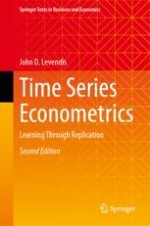2023 | OriginalPaper | Buchkapitel
4. Stationarity and Invertibility
verfasst von : John D. Levendis
Erschienen in: Time Series Econometrics
Aktivieren Sie unsere intelligente Suche, um passende Fachinhalte oder Patente zu finden.
Wählen Sie Textabschnitte aus um mit Künstlicher Intelligenz passenden Patente zu finden. powered by
Markieren Sie Textabschnitte, um KI-gestützt weitere passende Inhalte zu finden. powered by
